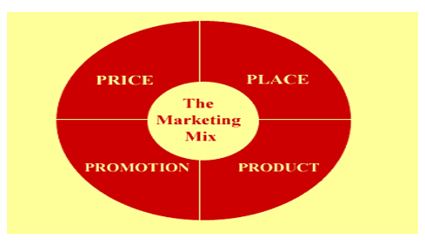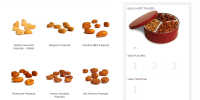The marketing mix is probably the most famous phrase in marketing. The elements are the marketing ‘tactics’. Also known as the ‘four Ps’, the marketing mix elements are price, place, product, and promotion.
The concept is simple. Think about another common mix – a cake mix. All cakes contain eggs, milk, flour, and sugar. However, you can alter the final cake by altering the amounts of mix elements contained in it. So for a sweet cake add more sugar! It is the same with the marketing mix. The offer you make to your customer can be altered by varying the mix elements. So for a high profile brand increase the focus on promotion and desensitize the weight given to price.

Promotion
Another one of the 4P’s is ‘promotion’. This includes all of the tools available to the marketer for ‘marketing communication’. As with Neil H.Borden’s marketing mix, marketing communications has its own ‘promotions mix.’ Think of it like a cake mix, the basic ingredients are always the same. However if you vary the amounts of one of the ingredients, the final outcome is different. It is the same with promotions. You can ‘integrate’ different aspects of the promotions mix to deliver a unique campaign. The elements of the promotions mix are:
1. Personal Selling 2. Sales Promotion 4. Public Relations 4. Direct Mail
5. Trade Fairs/Exhibitions 6. Advertising 7. Sponsorship
Product
The Product Life Cycle (PLC) is based upon the biological life cycle. For example, a seed is planted (introduction); it begins to sprout (growth); it shoots out leaves and puts down roots as it becomes an adult (maturity); after a long period as an adult the plant begins to shrink and die out (decline).
Place
Place is the mechanism through which goods and/or services are moved from the manufacturer/ service provider to the user or consumer.
Different choices of place include: Wholesalers, Agents, Retailers, The Internet
- The Internet has a geographically disperse market.
- Niche products reach a wider audience e.g. Scottish Salmon direct from an Inverness fishery.
- There are low barriers low barriers to entry as set up costs are low.
- Use e-commerce technology (for payment, shopping software, etc)
- There is a paradigm shift in commerce and consumption which benefits distribution via the Internet.
Price
There are many ways to price a product. Let’s have a look at some of them and try to understand the best policy/strategy in various situations.
Premium Pricing
Use a high price where there is uniqueness about the product or service. This approach is used where a substantial competitive advantage exists. Such high prices are charge for luxuries such as Cunard Cruises, Savoy Hotel rooms, and Concorde flights.
Penetration Pricing
The price charged for products and services is set artificially low in order to gain market share. Once this is achieved, the price is increased. This approach was used by France Telecom in order to attract new corporate clients.
Economy Pricing
This is a no frills low price. The cost of marketing and manufacture are kept at a minimum. Supermarkets often have economy brands for soups, spaghetti, etc.
Price Skimming
Charge a high price because you have a substantial competitive advantage. However, the advantage is not sustainable. The high price tends to attract new competitors into the market, and the price inevitably falls due to increased supply. Manufacturers of digital watches used a skimming approach in the 1970s. Once other manufacturers were tempted into the market and the watches were produced at a lower unit cost, other marketing strategies and pricing approaches are implemented.
Other Pricing Strategies
Psychological Pricing
This approach is used when the marketer wants the consumer to respond on an emotional, rather than rational basis. For example, pricing at 99 cents not one dollar.
Product Line Pricing
Where there is a range of product or services the pricing reflect the benefits of parts of the range. For example car washes. Basic wash could be $2, wash and wax $4, and the whole package $6.
Product Bundle Pricing
Here sellers combine several products in the same package. This also serves to move old stock. Videos and CDs are often sold using the bundle approach.
Promotional Pricing
Pricing to promote a product is a very common application. There are many examples of promotional pricing including approaches such as BOGOF (Buy One Get One Free).
Value Pricing
This approach is used where external factors such as recession or increased competition force companies to provide ‘value’ products and services to retain sales e.g. value meals at McDonalds.

















